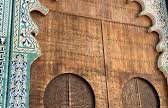Rabat – Algeria recently received the silver medal for best exterior design at Expo Osaka 2025, with its pavilion’s façade being praised for what organizers called “Algerian Zellige.” However, this term is not just a misnomer; it represents the erasure of history. The label “Algerian Zellige” is a cultural distortion, one that attempts to strip this centuries-old Moroccan art form of its true origins, reducing it to a decorative feature for international display.
Zellige is not a generic North African design; it is a Moroccan craft with deep roots in the country’s architectural history. Originating in the madrasas of Fez and perfected in the courtyards of Marrakech and Meknes, Zellige is more than just a pattern—it is a cultural cornerstone. The intricate mosaics, tiled minarets, and ornate fountains of Morocco are testaments to the craftsmanship and artistic dedication that have made Zellige a symbol of the country’s heritage.
To mislabel Zellige as something other than Moroccan is to undermine the very essence of an art that has been preserved through centuries of precision, geometry, and devotion.
Heritage Transformed Into Appropriation
The story of Zellige’s origins is intricately tied to Morocco’s rich architectural history. Emerging during the reign of the Almoravids and refined under the Almohads, the art reached its peak in the 13th and 14th centuries under the Marinid dynasty. It was in Fez where Moroccan artisans developed the art of interlacing geometric patterns, which today define Zellige.
Passed down through generations, Zellige is more than just a tile, each hand-cut piece, made from glazed clay and colored with natural minerals, is imbued with meaning. Its patterns represent harmony and infinity. This meticulous technique is unique to Morocco, with no other region replicating it with the same depth or continuity. Morocco did not merely adopt Zellige, it made it a central aspect of its architectural identity.
In recent years, Algeria has repeatedly tried to claim Zellige as part of its own national heritage, seeking to transform Morocco’s cultural symbols into tools of regional rivalry.
In 2022, during the controversy surrounding the Adidas football kits, Morocco’s Ministry of Culture filed a complaint against the German brand for using Zellige-inspired designs on Algerian national jerseys. Adidas later acknowledged the influence of Moroccan craftsmanship in the design. However, Algeria’s claims persisted, suggesting that Morocco’s cultural heritage is a collective asset shared equally by all Maghreb nations.
At Expo Osaka, Algeria once again adopted Zellige-like mosaics for its pavilion, presenting them as an expression of “local tradition.” This misrepresentation, however, overlooks the true origins of the art form and seeks to rewrite history.
The Danger of Dilution
Cultural appropriation often occurs subtly, not through overt theft, but by blurring the lines of identity and regionalizing something distinctive. By labeling Moroccan Zellige as a general Maghrebi or Algerian art, Algeria engages in a form of erasure that weakens Morocco’s cultural claim and authority. Once misattributed, heritage becomes difficult to reclaim.
For Morocco, cultural ownership is not only about recognition; it is a form of soft power. When Zellige is wrongly claimed, it risks undermining Morocco’s authority over how its history is represented.
Algeria has even sought to register “Algerian Zellige” with UNESCO, further muddying the waters surrounding the art’s true origins.
The issue of Zellige, then, becomes a matter of integrity. Algeria’s attempts to appropriate Morocco’s artistic identity are part of a broader strategy to project a sense of civilizational depth that it cannot sustain on its own. By adopting Moroccan symbols, Algeria seeks to bolster its own image, bypassing the continuity and authenticity that Morocco’s rich heritage offers.
Morocco’s Vigilance in Preserving Tradition
In contrast, Morocco continues to safeguard its cultural traditions through preservation, education, and recognition. Zellige from Fez, for instance, is officially registered with the World Intellectual Property Organization, and Moroccan artisans continue to train new generations in this time-honored craft.
For Morocco’s Ministry of Culture, these repeated instances of cultural appropriation can no longer be dismissed as isolated events. What’s at stake is not just the authenticity of an art form, but the preservation of national heritage itself. Morocco must take concrete steps to protect its intangible patrimony on the international stage.
Registering Zellige, the caftan, and other Moroccan cultural symbols in international legal frameworks should be a diplomatic priority. The battle over cultural ownership is not just symbolic; it affects Morocco’s ability to define its own history and preserve its legacy.
A Broader Rivalry
The ongoing tension between Morocco and Algeria extends far beyond politics or territorial disputes; it infiltrates the realms of diplomacy, culture, and even sports. For decades, Algeria has pursued a strategy of soft-power sabotage against Morocco, attempting to undermine its regional influence. When Morocco advances economically, Algeria stirs up political disputes. When Morocco’s cultural achievements gain recognition, Algeria seeks to mimic or distort them. This pattern is not coincidental but strategic.
Cultural appropriation, then, is simply one of the tools Algeria uses in its broader campaign to erode Morocco’s symbolic and moral leadership in the Maghreb.
Zellige is not the only victim of this strategy. Algeria has previously attempted to claim the Moroccan caftan as part of its own heritage, despite overwhelming evidence of its Moroccan origins. Even Morocco’s southern provinces have not escaped Algeria’s revisionist tendencies. Algeria continues to challenge Morocco’s sovereignty over the Western Sahara, promoting a separatist narrative that ignores the region’s historical and cultural ties to Morocco.
The same logic that drives Algeria to appropriate Moroccan art is evident in its stance on the Western Sahara—a refusal to acknowledge Morocco’s territorial, cultural, and civilizational depth, coupled with an obsession with obstructing its ascent.
